The BEST 2 way speakers little money can buy
...are worse than 3-way?
Yes.. and no. The thing is a certain combination of drivers might require a
crossover double the cost of the drivers. It'll sound good, but elegant it's not. And there's a cost in power loss, too. Not to mention that more drivers are naturally less efficient.
So you can use a hugely powerful amplifier to drive a speaker that behaves like a load of bricks- sort of like an american 'sports' car. Or you can design a speaker that is much more responsive; efficient drivers coupled through a crossover with the least components; sort of like an english sports car. It's elegant, and should be cheaper, too. Such elegance is easier to attain with 2 driver than 3. In fact, past 2 way you often see a leap to 3.5 or other exotic multidriver solutions with a crossover that could heat a room.
Full Range Drivers then?
So if less is more, even less should be even more, amirite? Full range drivers cover the entire spectrum, and so you need only one speaker, in theory. However, they have weak bass that requires an enclosure that can invert the phase. So a bass-reflex, horn, transmission line.. All of which bring their own issues to the table.
The biggest issue however is that they are a point source. Beautiful for that warm classical music where the whole room comes into play, acting as a concert hall. But I'm looking to build a home theatre system. This means as less dispersion as possible: rear speakers will act as the 'room'. Ideally you're looking for a 'sweet spot' the size of your couch.
Well, what about horns?
A horn speaker has a beautifully directed dispersion pattern, just what the doctor ordered. However, a horn only really works well on a specific frequency... you'd need lots of different horns to take advantage of one driver. There are, in fact, designs that do just that.
Volvotreter's site gives you a good idea of how it would look- and the WAF and placement issues of such a system.
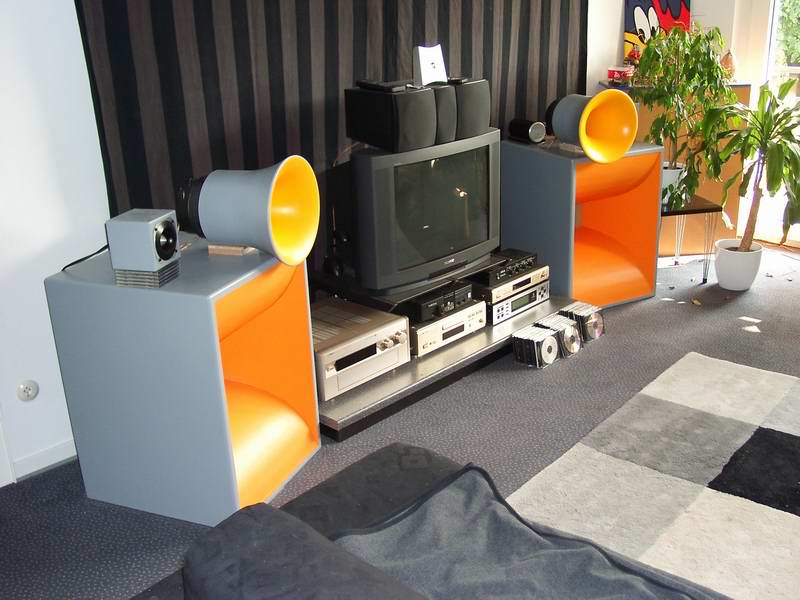
Another point against horns is the 'beaming' on axis where higher frequncies are bundled more than mid ones. There's solutions for this though, a simple one being a cut-off and seperate tweeter- but then we're back to the complexity of crossovers.
So you can't win?
Now we're getting somewhere... Don't forget the all-important WAF, neither. And try and remember that counter to that is a gadget freak trying to express himself. The more obscure your speaker design, the happier you might think you'll be. But is it worth the hassle?
The plan.
A two-way design to keep costs down. Now for a home theatre system the most important sound placement is that of the human voice. So there's a good reason to keep that crossover as far away from the human voice as possible. I've found a few references placing the highest frequency at 3k or 3400hz and the lowest at 85 hz. THX puts the subwoofer crossover at 80hz. Given the slope this means the speaker need not go lower than 50 hz and no higher then 3400hz. A tweeter will pick up the high end, the low end will be handed to a subwoofer.
Caveat
Now there's a caveat. I'm assuming such a driver will give a good flat response in the range of the human voice. It might however be that a design with a lower crossover has better results. It will depend on the crossover design, driver performance, baffle step, etc. As the Dutch say: 'meten is weten'.
Checklist
I Started by making made a list of DIY 2way speakers that have been built to good results. I used many sites, but in the end only the speakers found on lautsprechershop.de (strassacker)made it as their information was consistent- after setting a standard I could easily add other designs. I wanted to spend less than 300 euro a pair for pieces, excluding woodwork, glue, possible replacement binding posts and those spiky things which my SO never need know the cost of.
First step in triage was to check the crossover frequency.
The average crossover turned out to be 2650hz. But there were many crossovers on or over 3000hz, wich suited my 'human voice' theory.
At the bottom end I needed to make sure they could follow the THX cutoff down from 80hz to 50hz. Not many passed that test.
The next thing I wanted to check for was the simplicity of the crossover. Itt might be a simplistic ide, but I do believe that 'less is more'. However there is more to it; i also believe that issues should be dealt with in the enclosure design as much as possible. Well, mostly so I can show off what I picked up on speaker design, which is not on the electronics side.. I never did do my electronics homework (sorry mr. Van Haelst).
The average amount of parts was 7.5, although the Visaton 5750 set with 16 parts (guessed from picture) took the crown.
The last thing I wanted to look for was efficiency. Here I had to rely on the values from strassacker.com.
All of these criteria narrowed down my list to a handful of contenders
CC83:
Mission 2313
B.Timmermanns
Hobby hifi
XO at 3000Hz, bottoms out at 46Hz, and 91db sensitivity. Very good value for money, can be built as a 380 mm high sealed cabinet, but those Mission CP 138 drivers! Ug-lee!
Flip a coin..
..and you know immediately what you wish for. Not that the selected speakers were bad, but they just didn't get my heart pumping.
The speaker I was hoping for was the CerAl 4.2 And this mainly because of the look of it's aluminum Tang Band drivers.
So why did it fail to make the selection? First of al it had a cut-off frequency of 2500hz. Which meant depending on the slope it would cut over in the high end of human speech. Again, this need not necessarily be an issue; I needed to take a look at a response graph.
At the bottom end though, we were in trouble... 69hz at -8db? It's not a problem as far as the human hearing is concerned- we stop hearing direction at about 150hz- but would THX's crossover slope work? If not I'd neet to set a higher crosover in the receiver, wich might not be the optimal way to treat the material.
If the design had one glaring problem it was being new. No-one had built them yet, no-one had tested them yet, outside of K+T magzine.
From the ground up
Either way, I had a functional stero set, so as I came into a limited budget I prioritized bought the subwoofer set. I looked at the subwoofer enclosure that came with the set, and while I could certainly go smaller (bassexciter anyone?) I liked the size. In fact, it had about the same volume as the 'chinese' cabinets I was looking to build and put under my components.
After some research on downfiring subwoofers I settled on a temporary re-design with the same volume, and made some sketches for the missus. My brownie points appeared sufficient; permission was granted, more or less. Acting fearlessly I orderered the parts- and that is where the saga ends, for now.
To the subwoofer!
In strange aeons..
..one learns much, much more than a mere mortal should. About voices for example, and listening. I had come across the whole 'voice' thing a lot while researching for my speaker choice. Most of it was off-handed remarks by designers and hobbyists.
'The human voice is placed mostly between 100hz and 2000hz' or other thumb rules of this kind. At one point, I dug deeper, and found actual voice experts treat the subject amtter slightly different.
Here's a link that shows you how different.
One nugget of gold on the same site was a test where you could check your own 'frequency response'. This was my response, with crappy headphones, during daytime across from a construction site:

(I'll try to measure my response again, at home and in the evening- there's another construction site right around the corner- with sennheiser open back headphones) Beware: this shows relative sensitivity rather than absolute unless you calibrated your system.
But the site gave me a good idea of what is important: not the voice, which covers the whole spectrum, rather than the bit always mentioned, but the range we can hear, and in that range the harmonics and timing. Put an orchestra in a cathedral and its acoustics become more important than the instruments'. Feed a recording trough your ears and- exactamundo.
Ear-based design
So my ears, using crappy headphones, have their best response at about 6000hz - the graph tends to underestimate the dropoff in sensitivity at the lower end. I roughly adjusted the first graph in Paint to give you a better idea.

It's pretty brutal. To be honest, I don't buy the 6000hz much- it seems way to high- and likely due to the headphones.
But let's accept this for moment. One thing that catches my eye is the part beyond 3000hz. Even the site where I got the test mentions frequently how the human hearing is focused up to 'about 3khz'or, alternatively, 5khz.
Anyway, this all meant I started looking for a driver with a flat response in the range 1khz-16khz. The idea was to get a nice natural dropoff at the bottom and plug in a small woofer(once my son gets old enought to want to listen to music perhaps I could add a supertweeter- but I'm getting too old and realistic to care about that range myself. Mind you I'd have to design the crossover to allow the tweeter later on with minimal changes).
That being said most drivers that have a horrible response, even on-axis, beyond 2000hz. Many manufacturers- well, some in particular, Tang-band I'm looking at you- give 'optimistic' response curves for their drivers. Such drivers one can either correct with electronics- or by adding a tweeter. So unless the driver was truly flat up to 16khz I'd likely have to accept a three-way system.
A driver going from 1Khz to 16Khz is almost by definition a Full Range. But Full Range drivers are usually built to extend down rather than up- the default speaker design would be a full range with bass reflex support and a tweeter. I searched extensively for alternatives, and a few people did make full range / woofer combinations, but they were (typically) extremely wobbly in the high end. Now I've been using my Phillips full/woofer 2-ways for over ten years, and they're the speakers I'm used to. This was one of the main reasons for looking in this direction- but perhaps it was not worth it- certainly I'd get used to whichever design I'd build.
Taking the easy way.
So it was back to the drawing board. Perhaps it was time to, for once, not re-invent the weel. If you look for a standard you'll find ISO 226 lower on the hearing test page. The revised standard shows a steep dropoff below 500hz and above 6000hz, with a drop in sensitivity around 1500hz.
I was going to take some things along from my search. If you look for a standard you'll find ISO 226 lower on the hearing test page. The revised standard shows a steep dropoff below 500hz and above 6000hz, with a drop in sensitivity around 1500hz. It seemed to me 1500hz would be a good place for a crossover.
I'd come across a number of attractive speaker designs during my search. I went back and looked at the practicalities of all of them.
Zaph BAMTM
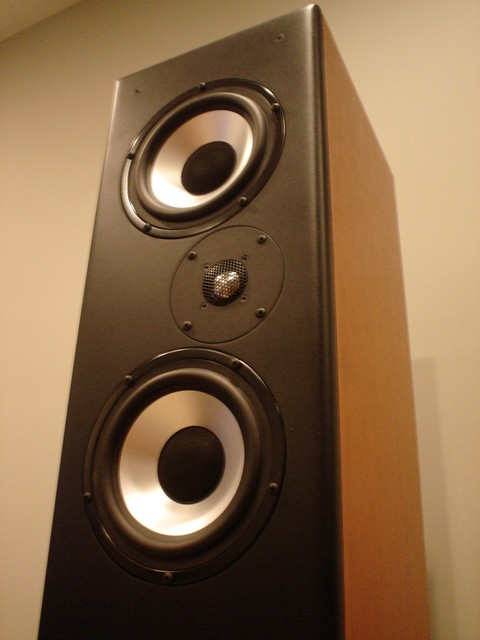
John “Zaph” Krutke has designed quite a few speakers, but these were built to be "Cheap and simple with great sound".
The 'Bargain Aluminum' MTM design uses the Seas 27TBFCG tweater which Zaph selected based on very extensive testing. Zapp guarantees good sound, and I liked the look of the aluminum mids. SEAS is Norse, and so the prices here in Europe could be significantly lower than those in the US. Their speaker designs feature the legendary Thor and Odin, which I knew to be firmly beyond my budget, but the Seas 27TBFCG was a budget tweater so I had high hopes.
I started with their german distributor, Intertechnik.com , but they didn't have it in their catalog. Neither did french Toutlehautparleur.com.
At clofis.nl they weren't in the assortment either.
At the U.S. Madisound the tweaters were 43 euros (crisis? inflation?) but could they deliver?
So the question became: which tweeter could replace it? According to Zaph, none- his designs are as is and cannot be changed.
End of line for Zaph...?
DAYTON RS150MTM
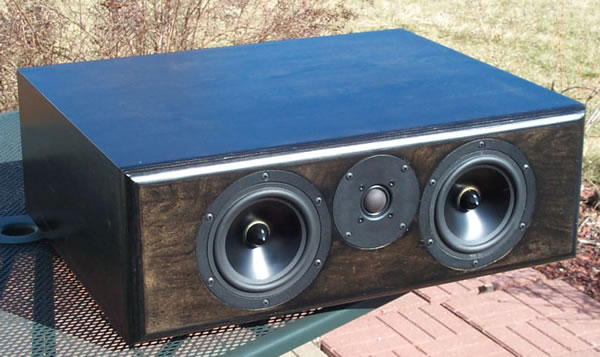 The RS 150 MTM
The RS 150 MTM is a series of MTM designs based on a Seas tweater- again, the problem with Seas tweeters being that nearly the whole product line was discontinued, bumping prices up and availability down. Either way the design proved too bulky and pricey to entertain as a serious contender.
Lineup D44
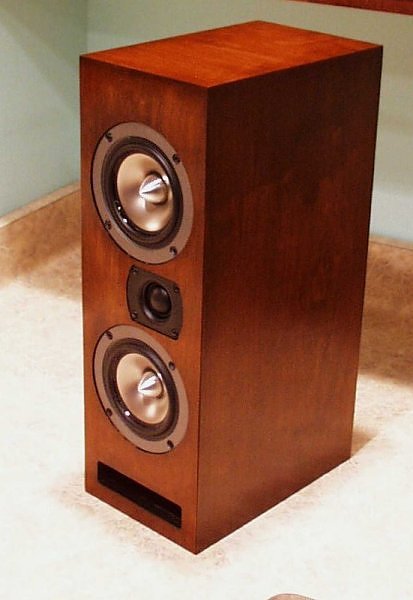
The HT guide forum produces a lot of speaker designs, but (typical american?) they tend to the larger.
This design series caught my eye because it was smaller- and cheaper- than the others. The several variations had been built quite a few times and people seemed satisfied with the reults. Unfortunately, over time the tweeter used became- you guessed it- unavailable. So the design became obsolete.
Settling on a design.
Coincidentally I'd learned that the Monacor CerAl 4.2 speakers I was pining for sounded very harsh when combined with my Onkyo Amplifier. Further research indicated that indeed, my beloved toaster has a reputation for beeing screechy. On my Philips speakers I'd never notice, of course...
Tony Gee's Paper HATT
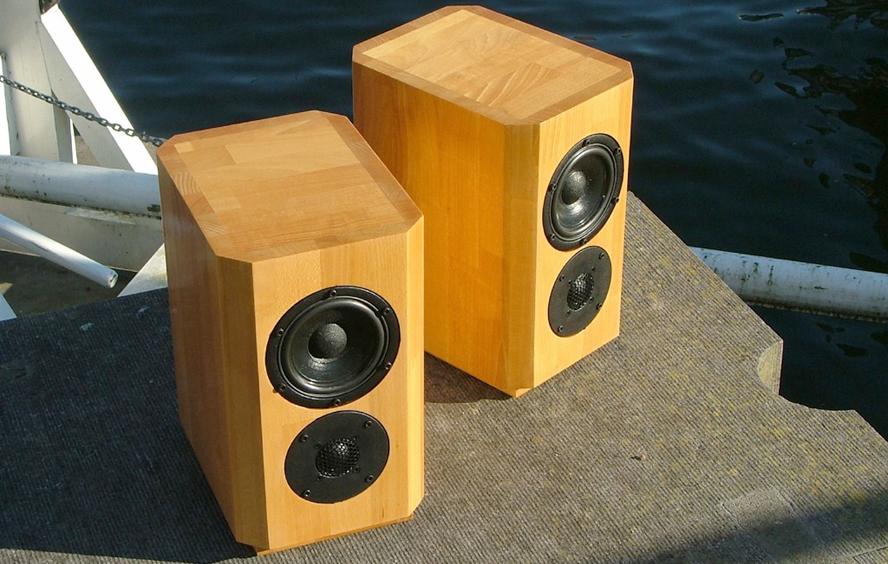
It's small, it sounds good, and it's paper. Tony's designs are de rigeur on a Dutch audio forum I frequent, and many people have built them.
The HATT is a design that has gone through several incarnations, and this one was designed specifically to sound 'paper' like.
60 euro for the woofer, 72 for the tweeter, 10 euros for the few coils, and another 30 euros for the resistors, brings me up to 172 euros for electronics only.
Zaph ZBM4
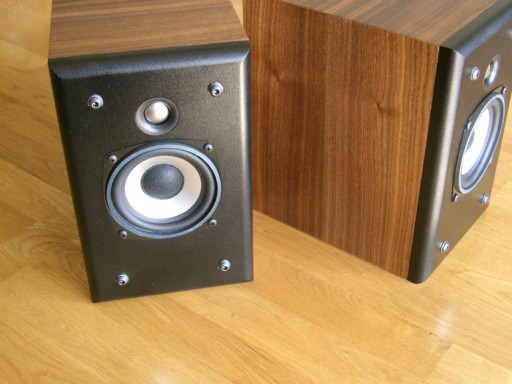
Zaph is back... This design is even smaller than the HATT, and much cheaper- the big question is how much?
The answer seems to be that the woofer is very hard to get. On top of that these are small speakers that need a lot of juice- low efficiency.
Perhaps in the end, too small for my purpose? I've been wondering if it's worth replacing my 35*25*20 Philips speakers with smaller ones- I'd never be able to 'upgrade' afterwards, WAF being what it is.
What I need is perhaps taller than the HATT.
Another thing is that even though my Onkyo sounds a bit shrill, this might not prohibit metal woofers- and they would sure be safer around cats and baby.
Zaph ZMV5
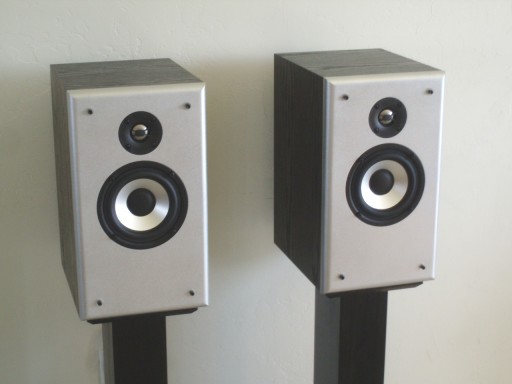 This design
This design is bigger than the ZBM4, so that's good. They're not much pricier, neither. Getting the drivers though... They'll have to be ordered from the states.
Apart from that they seem great value- especially with a high subwoofer crossover.





 John “Zaph” Krutke has designed quite a few speakers, but these were built to be "Cheap and simple with great sound".
John “Zaph” Krutke has designed quite a few speakers, but these were built to be "Cheap and simple with great sound". The RS 150 MTM is a series of MTM designs based on a Seas tweater- again, the problem with Seas tweeters being that nearly the whole product line was discontinued, bumping prices up and availability down. Either way the design proved too bulky and pricey to entertain as a serious contender.
The RS 150 MTM is a series of MTM designs based on a Seas tweater- again, the problem with Seas tweeters being that nearly the whole product line was discontinued, bumping prices up and availability down. Either way the design proved too bulky and pricey to entertain as a serious contender.
 The HT guide forum produces a lot of speaker designs, but (typical american?) they tend to the larger. This design series caught my eye because it was smaller- and cheaper- than the others. The several variations had been built quite a few times and people seemed satisfied with the reults. Unfortunately, over time the tweeter used became- you guessed it- unavailable. So the design became obsolete.
The HT guide forum produces a lot of speaker designs, but (typical american?) they tend to the larger. This design series caught my eye because it was smaller- and cheaper- than the others. The several variations had been built quite a few times and people seemed satisfied with the reults. Unfortunately, over time the tweeter used became- you guessed it- unavailable. So the design became obsolete.
 Zaph is back... This design is even smaller than the HATT, and much cheaper- the big question is how much?
Zaph is back... This design is even smaller than the HATT, and much cheaper- the big question is how much? This design is bigger than the ZBM4, so that's good. They're not much pricier, neither. Getting the drivers though... They'll have to be ordered from the states.
Apart from that they seem great value- especially with a high subwoofer crossover.
This design is bigger than the ZBM4, so that's good. They're not much pricier, neither. Getting the drivers though... They'll have to be ordered from the states.
Apart from that they seem great value- especially with a high subwoofer crossover.
